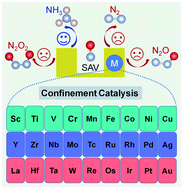Confinement catalysis of a single atomic vacancy assisted by aliovalent ion doping enabled efficient NO electroreduction to NH3†
Abstract
The electrocatalytic NO reduction reaction (NORR) to NH3 is emerging for simultaneous harmful NO removal and valuable NH3 synthesis. However, usually NO-to-NH3 efficiency can be significantly suppressed due to N–N bond coupling or N atom diffusion. The confinement catalysis of an angstrom-size single atomic vacancy (SAV), distinct from the traditional nano-size confinement catalysis, may provide a unique solution for this. Herein, using the system of 1H-MoS2 with a sulfur single vacancy, we theoretically demonstrate that SAVs can achieve excellent selectivity of NO-to-NH3, attributed to their spatial confinement effect. Moreover, NORR activity can be optimized by aliovalent ion doping, which modulates the polarization charge distribution of active sites and consequently changes the intermediate binding strength effectively. Accordingly, six promising NORR catalysts with high activity, selectivity, and stability are screened out, among which La-doped MoS2 with a sulfur SAV exhibits an ultralow limiting potential of −0.15 V. More importantly, the formation energy for the sulfur SAV is identified as an intrinsic descriptor for designing NORR catalysts. This contribution provides an efficient strategy for direct NO-to-NH3 conversion and particularly extends the concept of confinement catalysis to the case of single atomic vacancies, which may also apply to other reactions.

- This article is part of the themed collection: Journal of Materials Chemistry A HOT Papers


 Please wait while we load your content...
Please wait while we load your content...